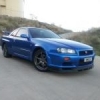Announcements
-
Similar Content
-
Latest Posts
-
I will reiterate... Pull the ABS fuse... At a minimum, good test to see if it's actually being caused by the ABS system... At the other end of the scale, if the vibration is from ABS turning on, last thing you want is when you're trying to brake, having ABS kick in when it shouldn't and now you can't actually stop at all... At least with ABS unplugged the worst issue is you need to be aware you're the one that needs to modulate pressure in an emergency.
-
Uses the factory sensors? Which are currently the problem?
-
By Dose Pipe Sutututu · Posted
You can swap between OEM position or closer to chassis. Allows the suspension arms to be a bit more closer to OEM height geometry. My LCAs actually point down now, where as before they were flat. Overall real noticeable difference is I can put down close to 440kW on the street with no wheel spin. -
By Murray_Calavera · Posted
@silviaz Sounds like your making progress. Let me know how the door goes after you've got the primer down.
-








Recommended Posts
Create an account or sign in to comment
You need to be a member in order to leave a comment
Create an account
Sign up for a new account in our community. It's easy!
Register a new accountSign in
Already have an account? Sign in here.
Sign In Now